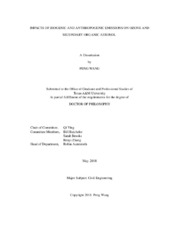| dc.description.abstract | Atmospheric fine particles and ozone (O3) are correlated with adverse health effects,
visibility reduction, and climate change. In recent decades, China has suffered from the
record-breaking severe haze event and elevated ozone problems. Recent field measurements
show that organic carbon (OC) was one of the major components during haze events,
and it has been suggested that secondary organic aerosol (SOA) could account for a significant
fraction of the total observed OC. Quantitative knowledge of the contributions of
different emissions sources to SOA and ozone concentrations is significant to better understand
their formation mechanisms and is useful to develop the effective emission control
strategies. A Community Multiscale Air Quality (CMAQ) model with source-oriented
lumped SAPRC-11 (S11L) photochemical mechanism is applied to determine the contributions
of anthropogenic and biogenic sources to SOA and ozone concentrations in China.
In China, predicted SOA concentrations are generally higher in summer (10-15 µg·
M^-3) due to large contributions of biogenic emissions within China (country average
~60%) and in winter due to industrial and residential sectors (country average ~78%
total) based on the Multi-resolution Emission Inventory for China (MEIC) emission inventory.
However, the transportation sector (~30-40% vs. ~5% by MEIC) is predicted to
be much more important while the residential (~21-24% vs. ~42%) sector is predicted to
be less important based on The Regional Emission inventory in ASia v2.1(REAS2) emissions.
These discrepancies in source contributions to SOA needs to be further investigated
as the country seeks optimal emission control strategies to fight severe air pollution.
The ozone attribution scheme based on the three-regime definition was incorporated
into the CMAQ model to quantify NOx and VOC contributions to ozone concentrations
in China in August 2013. Most of the areas considered by the two-regime approach as
NOx or VOC-limited are classified as transitional under the new three-regime scheme,
and the scattered VOC-limited regimes are located in urban areas. This three-regime approach
represents an improvement from the traditional two-regime approach with only
NOx or VOC-limited regimes. This three-regime method then is applied in the ozone
source apportionment as well, and it is reported that the industries, transportation, power
and biogenic sources are four major emission contributors to ozone with different spatial
distributions. | en |


